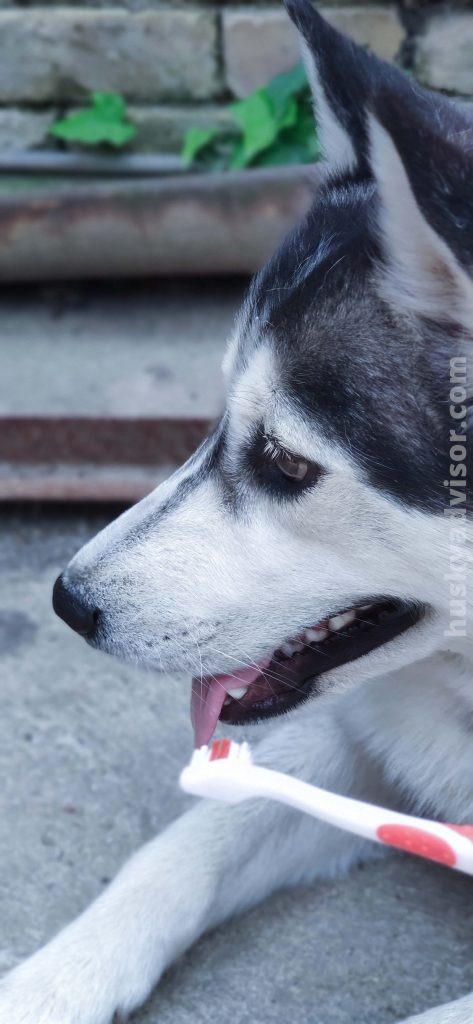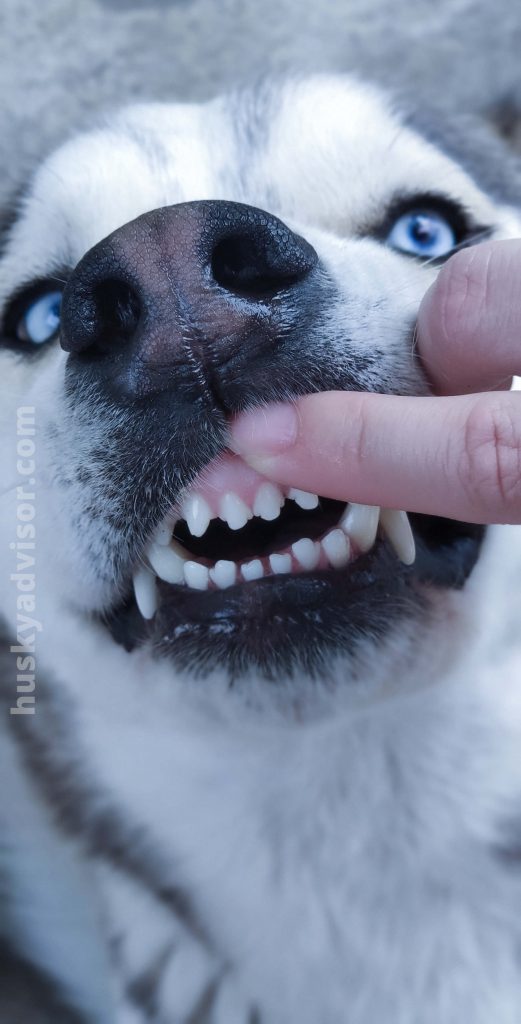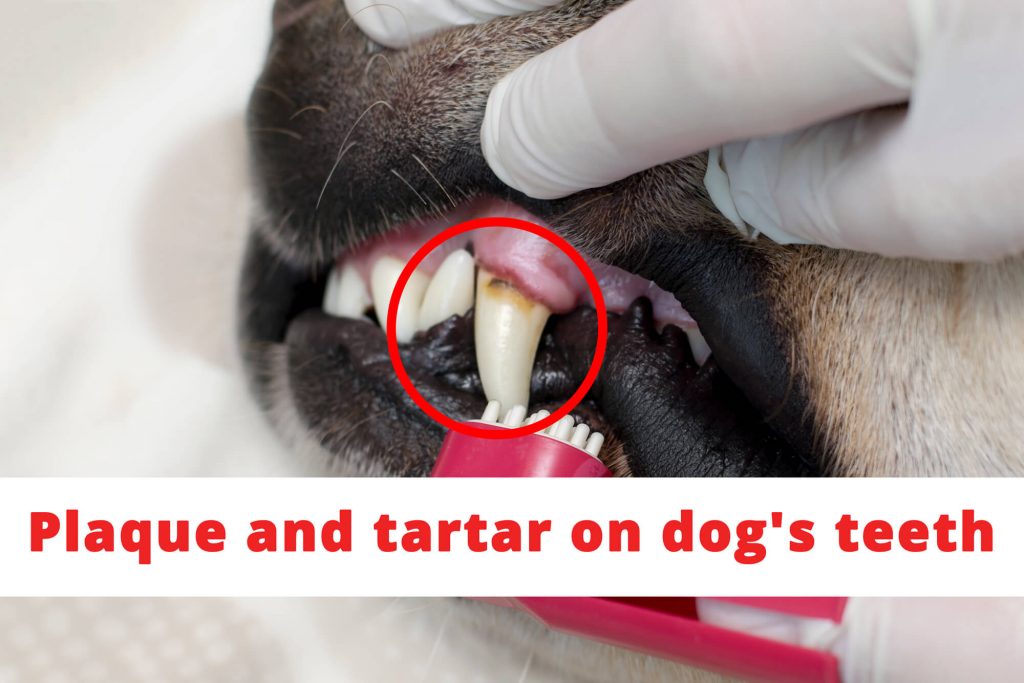Your husky’s teeth are a part of his or her overall health. Like human teeth, a husky’s teeth develop cavities, tartar, and gums problems resulting in tooth loss. Not brushing your Siberian husky’s teeth will result in bad breath that can break human and dog interaction. It is terrible when a dog opens the mouth and you smell bad breath and see sore or bleeding gums and plaque on the teeth. Yikes! If the owners get disgusted by a dog’s breath, can you imagine how that dog is feeling with bleeding gums? A dog’s bad mouth is a sign of neglect on the part of the owner. Let’s brush our dog’s teeth regularly to avoid these kinds of health problems. While you’re brushing your husky’s teeth, you can also look for any signs of mouth injuries, tooth pain, or other problems.
How can I brush my husky’s teeth?
You can start to brush your husky’s teeth at an early age so he or she will get used to brushing and allow you to touch the teeth. If you have a puppy husky, you can start brushing when he or she is eight weeks old.
Make brushing your dog’s teeth a good experience for your dog. Don’t force it! Your husky has to be comfortable with you touching his mouth, with the special dog toothpaste, and with the brush. You can buy a Beaphar Toothbrush and Toothpaste Kit from here and start brushing your husky’s teeth. The toothpaste liver taste is liked by most dogs, and you can use the small end of the brush for the front teeth and the large brush for the back teeth. Your huskies mouth will not smell like liver, it just has the liver taste.
How can I brush my husky’s teeth for the first time?
With Siberian huskies is important to pick your battles. Huskies have a massive appetite for nibbling and playing, especially husky puppies, so you need to choose the right moment and place to brush your husky. You can start brushing your dog’s teeth from the age of eight weeks. Be careful when you’re brushing your puppy teeth because of the teething. If you didn’t begin to brush your dog’s teeth yet, you should know that it is never too late to start.
1. Buy a proper dog toothbrush and dog toothpaste
When you buy a toothbrush for your husky, make sure to pick a toothbrush with soft bristles because you don’t want to cause discomfort to your dog while you’re brushing the teeth. Always pick a toothpaste specially designed for dogs. Do not use regular toothpaste. Do not brush your dog’s teeth with toothpaste made for humans. The toothpaste intended for human use contains ingredients that shouldn’t be consumed or ingested by dogs. Most types of toothpaste made for human use contain xylitol or a high level of sodium or other ingredients bad for your dog’s health. Xylitol is an artificial sweetener that is toxic for dogs.
Quick reminder! Xylitol is toxic for dogs
As a quick reminder, always watch for artificial sweeteners in foods before feeding some to your dog. Nowadays, artificial sweeteners are used in a large variety of products. Toothpaste, yogurt, peanut butter, baked goods, pudding, syrups, sauces, chewing gums, candies, and many more, can contain xylitol. When it comes to foods, always check the label and see if it contains xylitol before you share a bite with your dog. If xylitol is not mentioned, you should also check for sugar alcohol. If sugar alcohol is mentioned on a product, there have been used more and different ingredients to sweeten the products, but we are not aware of the xylitol amount used.
We know for sure that the product is sweetened with sugar alcohol such as xylitol, and xylitol is toxic for dogs. Signs of xylitol poisoning in dogs can include vomiting, lethargy, weakness, hypoglycemia, seizures, liver failure, and even death. With all this being said about xylitol, make sure you get a toothpaste specially designed for dogs. Don’t brush your dog’s teeth with toothpaste designed for human use. Dog-safe toothpaste is safe to swallow by your dogs, and it usually has tasty flavors such as peanut butter, beef, fish, and so many more to make brushing more appealing.
2. Find the right place, right position, and right time to brush your dog’s teeth
Introduce your husky to brushing on teeth in a place where your husky is feeling safe and comfortable. Try to find a moment when your husky is calm and touch his or her teeth with your finger, without brushing. At the end of a day or after a walk, your husky is calmer, so this is an excellent moment to introduce something new, such as tooth brushing or to learn new commands. Pet your husky and make sure he or she is calm. If your husky is in a playing mode and he or she jumps and runs, you shouldn’t try to brush his teeth for the first time.
Don’t tackle your dog, don’t stay in a ready-to-play position or in a position that can make your dog uncomfortable. We all love our dogs, but keep in mind that there is a possibility that some dogs may get even aggressive if you stay in a threatening position or if he or she is scared of brushing. A dog doesn’t know that dental care is good for him or her. Your dog sees you trying to stick your finger or a toothbrush into his or her mouth. Think about the dog’s perspective on this whole situation. So, if a dog gets aggressive, you should stop and try to calm yourself and him or her.
As I mentioned earlier, don’t force it and make sure that this is a pleasant experience for both of you. Let your dog sniff the toothbrush, lick some dog-safe toothpaste, and try again to touch his or her teeth with it. Don’t push it, a few seconds at first is perfect for a start. Tomorrow is another day, and you can try again. Make sure you and your dog are both calm.

3. Touch your dog’s teeth and gums without the toothbrush
Since they are puppies, dogs are usually used to having their mouth handled. If you have never handled your puppy’s mouth, then you should start. All you have to do is to raise his or her lip and hold it while you’re touching the teeth. Do the same with the bottom lip and teeth. This way your husky will be accustomed to you touching his or her mouth and teeth.
If you have an adult husky that isn’t used to you brushing his or her teeth you can try to do the same thing. If he or she is calm but doesn’t want to allow you to touch the teeth, you can put some peanut butter (without sugar or artificial sugars) or dog-safe toothpaste on your finger and allow him or her to lick it. Step by step, you can approach your dog’s mouth and touch the teeth and gums with your finger. Always be aware of your dog’s reactions and praise the good behavior.
You can even give him some treats. I know that peanut butter and treats can’t clean your husky’s teeth, but we are talking about how you can teach your dog that it is ok for you to touch his or her teeth and gums. The goal at this step is to teach your husky.
4. Let your dog sniff the toothbrush and the toothpaste
Let your husky sniff and taste the special made for dogs’ toothpaste. There are plenty of special dog-safe kinds of toothpaste with delicious flavors that can attract your dog. If your husky is calm, put some dog toothpaste on the toothbrush and brush your dog’s teeth. If it’s the first time when your brush your dog, don’t push it. Brush your husky’s teeth for 30 seconds or more if he or she is ok with it. Don’t force it. Make this a pleasant and positive experience. If your dog had enough after 10 seconds for the first time, you should stop because you can try later or tomorrow again.
Remember that you’ll need to brush your dog’s teeth his or her whole life, so it is essential to have a good start. You will need to spend a few more minutes to make him or she understand that brushing isn’t that bad, and your husky will be comfortable with you brushing his or her teeth.
5. Start brushing your dog’s teeth
You can now start brushing your husky’s teeth. Put some dog-safe toothpaste on a toothbrush, and start brushing your dog’s top teeth while you’re holding his top lip. Start from the front teeth and move further to the back. We need to get all the teeth cleaned. Don’t rush and make sure you have a toothbrush with soft bristles. After you brush the top teeth, do the same with the bottom teeth.
Try to focus on where the teeth meet the gum line and on the back teeth because there is where plaque and tartar build up faster. Brush your dog’s teeth with circular motions, and be sure you are not brushing too hard or too gentle. You’ll get the hang of it pretty soon. If it is the first time you brush your dog, don’t forget to praise him and even give him or her a tasty treat. Getting his or her teeth brushed must be a positive and pleasant experience.
How often should I brush my Siberian husky’s teeth?
You should brush your Siberian husky’s teeth at least three times per week in order to prevent plaque buildup and bad breath. If you have enough time and if your dog is easygoing, the ideal situation is to brush your dog’s teeth twice a day, especially after feeding. You can also brush your husky’s teeth at the end of each day. Try to find time in your busy schedule to brush your dog’s teeth because only this way you can avoid plaque buildup and give him a healthy mouth.
Brushing your dog’s teeth doesn’t take so long. You will need only two minutes to brush your husky’s teeth. If your dog wants to play when you brush his or her teeth it can take a bit longer. As long as brushing is a pleasant experience for your husky, you can spend a few more minutes with your furry buddy each day.
What happens if you don’t brush your dog’s teeth?
If you don’t brush your husky’s teeth, plaque will build up. You can see it as brown or yellow stains on your dog’s teeth, especially near the gums. So, if you wonder what the brown stains on your dog’s teeth are, this is how dental plaque looks. Plaque is a substance that can develop on your husky’s teeth after a meal in a few hours. The plaque starts to harden when the saliva, bacteria, and food particles are combined.
When the plaque is not removed by brushing, the plaque keeps building up with more minerals and results in hard tartar. Tartar is rough and is a place where bacteria grows and multiply. All the accumulated bacteria can cause gingivitis. Gingivitis is the inflammation of the gums and bleeding in your dog’s mouth. If the problem is not treated, gingivitis can lead to pain and tooth loss.
Therefore, not brushing your husky’s teeth will result in hard tartar on the teeth that will cause teeth decay, tooth loss, sore and bleeding gums, oral infection, and even tooth loss. If you didn’t brush your dog’s teeth you should know that it is not too late. Go to your veterinarian and ask for direction and advice. Your veterinarian will help your dog to have better oral hygiene and improve his or her life.
With what can I clean my husky’s teeth?
You can clean your husky’s teeth with a toothbrush with soft bristles and a special dog safe toothpaste. Besides this, you can use dental wipes, dental treats or chews, and even water additives. If your dog has tartar on his or her teeth, you should talk to your veterinarian and ask what is the best solution for your friend. Nowadays, there are plenty of tartar and plaque removers from powder, water additives, and even gel but it is better to prevent the build-up of plaque. Brushing your dog’s teeth once per day is the best solution for healthy oral hygiene.
How often should I have my dog’s teeth checked?
It would be best if you took your husky to have his teeth checked at least once a year. Your veterinarian will check and see I there are problems, and he or she will help your dog. If you notice that your dog has bleeding gums, excessively red gums, chipped tooth, damaged tooth, or difficulty when he or she tries to eat food, you definitely should go to the veterinarian. Don’t wait.
How can I clean the plaque of my dog’s teeth?
You can remove the plaque from your husky’s teeth if you brush his or her teeth daily with a toothbrush and a dog-safe toothpaste. Also, you can use specially designed powders or gel to remove the plaque. When you’re brushing your dog’s teeth, make sure you also make small circles along the gum lines. Don’t brush too hard. Besides the regular brushing, you can give your dog dental treats or chews and even wipe his teeth and gums with dental wipes. If your dog has too much calcar you should go to the veterinarian and ask for help. The veterinarian will check your furry friend’s teeth and give you the best advice. The plaque and tartar need to be removed to reduce your dog’s risk of getting tooth decay, gum disease, and other oral health issues.
Do dental treats work, and how often should I give my dog dental treats?
Nowadays, we can find many varieties of dental treats with different flavors. But do they work? Yes, dental treats work, but you still need to brush your dog’s teeth daily with a toothbrush and a dog-safe toothpaste – dental treats are not miracle workers.
You can use dental treats, dental chews, sprays, gels, and dental wipes beside the regular teeth daily brushing and not as a replacement. Always check the feeding chart found on the packaging of the dental treats and feed your dog according to what is written there. You can also give him to chew and play with a dental chew toy.
Veggies and crisp fruits for your dog’s teeth
In case this is not your first time on my blog, you already know that I feed fruits and vegetables to my huskies. If you want to give some healthy treats that can make your dog happy and clean his teeth a bit, you can give him carrot sticks, apple slices– make sure the core is removed, pumpkin pieces, and sweet potato. These are healthy dog-safe treats that help to remove the plaque from your dog’s teeth. Keep in mind these are just an addition to brushing your dog’s teeth daily.
Give your husky a healthy life by brushing his teeth daily
You need to put in the effort and find 3 minutes before bedtime to brush your husky teeth. A few minutes of your time means a life with no plaque or tartar for your dog. It is easier to prevent tartar and plaque build-up or gum disease, or bleeding gums than to deal with the problem when it is too late. Tooth decay and tooth loss are not small problems for your dog. He or she needs healthy teeth to chew, eat without problems, and enjoy a wonderful life. This is what we all want for our precious furry friends. Don’t forget to wash your hands after you brush your dog’s teeth. It is a myth that a dog’s mouth is cleaner than a human mouth. A dog has the same number of bacteria in his or her mouth as humans do, but you can’t contact any disease from your dog.
The exceptions are dogs that eat a raw diet because they are at high risk of contracting salmonella, and salmonella can be spread to humans. Still, even if your dog is not on a raw diet and can’t infect you with any disease, it is better to wash your hands because dogs usually discover the world with their mouth, especially when they are puppies.
So get brushing to make sure your dog looks like a superstar when smiling with all his teeth. It’s a healthy and bonding ritual that will help your friend have a pleasant life.



